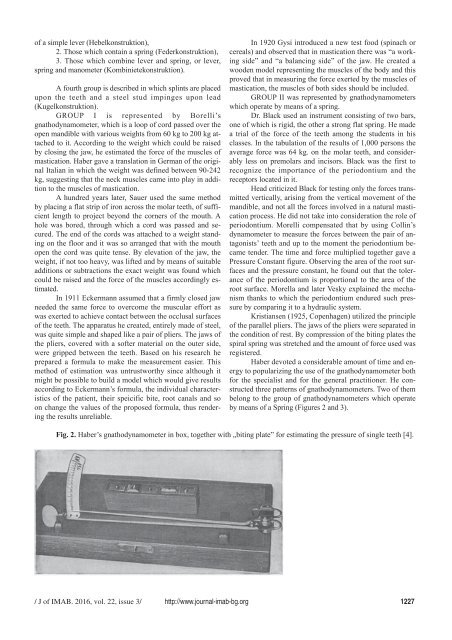JofIMAB-2016-vol22-issue3
You also want an ePaper? Increase the reach of your titles
YUMPU automatically turns print PDFs into web optimized ePapers that Google loves.
of a simple lever (Hebelkonstruktion),<br />
2. Those which contain a spring (Federkonstruktion),<br />
3. Those which combine lever and spring, or lever,<br />
spring and manometer (Kombinietekonstruktion).<br />
A fourth group is described in which splints are placed<br />
upon the teeth and a steel stud impinges upon lead<br />
(Kugelkonstruktion).<br />
GROUP I is represented by Borelli’s<br />
gnathodynamometer, which is a loop of cord passed over the<br />
open mandible with various weights from 60 kg to 200 kg attached<br />
to it. According to the weight which could be raised<br />
by closing the jaw, he estimated the force of the muscles of<br />
mastication. Haber gave a translation in German of the original<br />
Italian in which the weight was defined between 90-242<br />
kg, suggesting that the neck muscles came into play in addition<br />
to the muscles of mastication.<br />
A hundred years later, Sauer used the same method<br />
by placing a flat strip of iron across the molar teeth, of sufficient<br />
length to project beyond the corners of the mouth. A<br />
hole was bored, through which a cord was passed and secured.<br />
The end of the cords was attached to a weight standing<br />
on the floor and it was so arranged that with the mouth<br />
open the cord was quite tense. By elevation of the jaw, the<br />
weight, if not too heavy, was lifted and by means of suitable<br />
additions or subtractions the exact weight was found which<br />
could be raised and the force of the muscles accordingly estimated.<br />
In 1911 Eckermann assumed that a firmly closed jaw<br />
needed the same force to overcome the muscular effort as<br />
was exerted to achieve contact between the occlusal surfaces<br />
of the teeth. The apparatus he created, entirely made of steel,<br />
was quite simple and shaped like a pair of pliers. The jaws of<br />
the pliers, covered with a softer material on the outer side,<br />
were gripped between the teeth. Based on his research he<br />
prepared a formula to make the measurement easier. This<br />
method of estimation was untrustworthy since although it<br />
might be possible to build a model which would give results<br />
according to Eckermann’s formula, the individual characteristics<br />
of the patient, their speicific bite, root canals and so<br />
on change the values of the proposed formula, thus rendering<br />
the results unreliable.<br />
In 1920 Gysi introduced a new test food (spinach or<br />
cereals) and observed that in mastication there was “a working<br />
side” and “a balancing side” of the jaw. He created a<br />
wooden model representing the muscles of the body and this<br />
proved that in measuring the force exerted by the muscles of<br />
mastication, the muscles of both sides should be included.<br />
GROUP II was represented by gnathodynamometers<br />
which operate by means of a spring.<br />
Dr. Black used an instrument consisting of two bars,<br />
one of which is rigid, the other a strong flat spring. He made<br />
a trial of the force of the teeth among the students in his<br />
classes. In the tabulation of the results of 1,000 persons the<br />
average force was 64 kg. on the molar teeth, and considerably<br />
less on premolars and incisors. Black was the first to<br />
recognize the importance of the periodontium and the<br />
receptors located in it.<br />
Head criticized Black for testing only the forces transmitted<br />
vertically, arising from the vertical movement of the<br />
mandible, and not all the forces involved in a natural mastication<br />
process. He did not take into consideration the role of<br />
periodontium. Morelli compensated that by using Collin’s<br />
dynamometer to measure the forces between the pair of antagonists’<br />
teeth and up to the moment the periodontium became<br />
tender. The time and force multiplied together gave a<br />
Pressure Constant figure. Observing the area of the root surfaces<br />
and the pressure constant, he found out that the tolerance<br />
of the periodontium is proportional to the area of the<br />
root surface. Morella and later Vesky explained the mechanism<br />
thanks to which the periodontium endured such pressure<br />
by comparing it to a hydraulic system.<br />
Kristiansen (1925, Copenhagen) utilized the principle<br />
of the parallel pliers. The jaws of the pliers were separated in<br />
the condition of rest. By compression of the biting plates the<br />
spiral spring was stretched and the amount of force used was<br />
registered.<br />
Haber devoted a considerable amount of time and energy<br />
to popularizing the use of the gnathodynamometer both<br />
for the specialist and for the general practitioner. He constructed<br />
three patterns of gnathodynamometers. Two of them<br />
belong to the group of gnathodynamometers which operate<br />
by means of a Spring (Figures 2 and 3).<br />
Fig. 2. Haber’s gnathodynamometer in box, together with „biting plate” for estimating the pressure of single teeth [4].<br />
/ J of IMAB. <strong>2016</strong>, vol. 22, issue 3/ http://www.journal-imab-bg.org 1227



